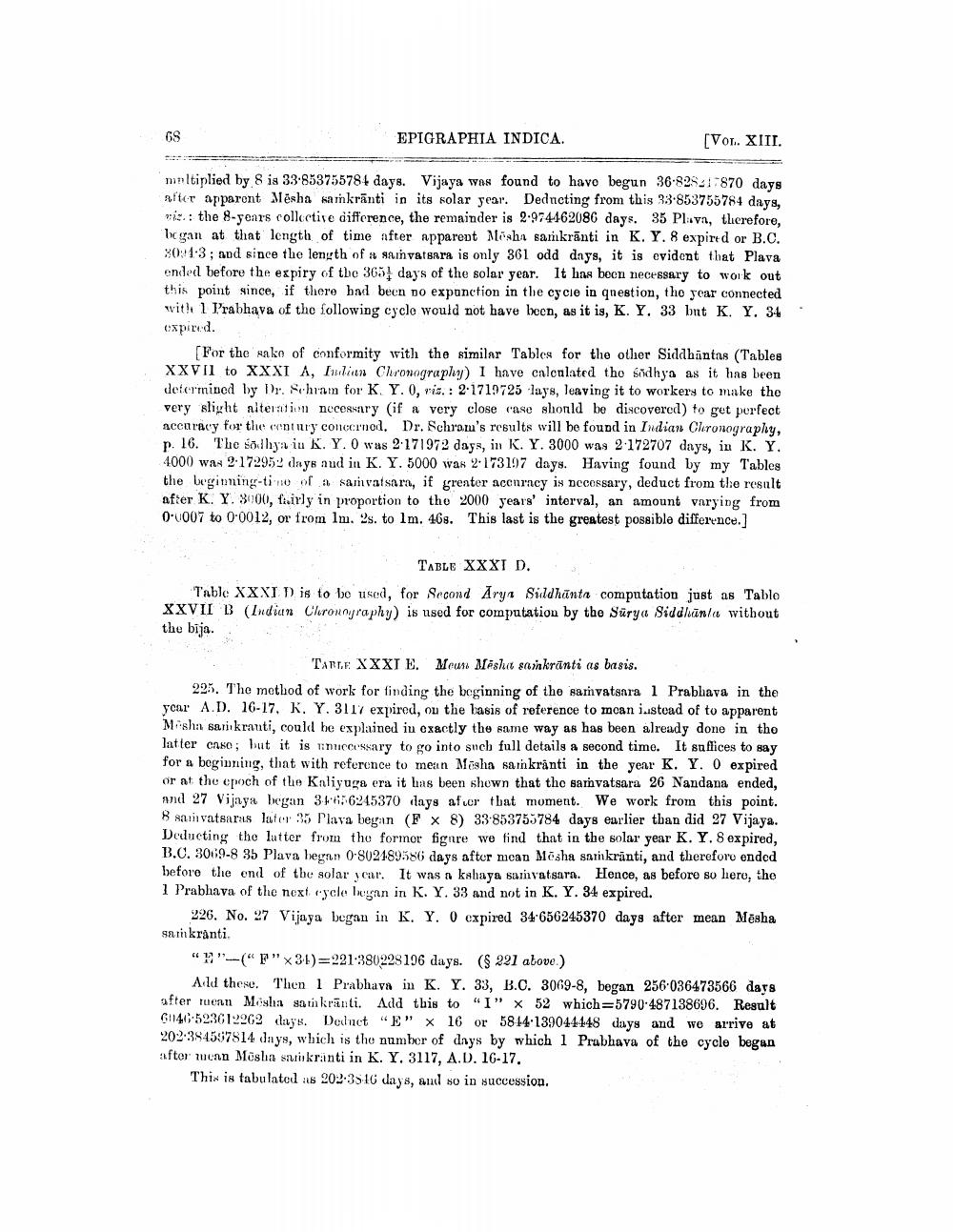________________
69
EPIGRAPHIA INDICA.
[VOL. XIII.
.
multiplied by 8 ia 33-853755781 days. Vijaya was found to have begun 36-82541 870 days after apparent Mēsha kaminkrānti in its solar year. Deducting from this 33.853755784 days, vis: the 8-years collective difference, the remainder is 2.974162086 days. 35 Plavn, therefore, began at that length of time after apparent Mesha sankrānti in K. Y. 8 expired or B.C. 30:1-3; and since the length of st samvatsara is only 361 odd days, it is evident that Plava ended before the expiry of the 3654 days of the solar year. It has been necessary to work out this point since, if there had been no exponction in the cycle in question, the year connected with: 1 Prabhava of the following cyclo would not have been, as it is, K. Y. 33 but K. Y. 34 expired.
[For the sake of conformity with the similar Tables for the other Siddhantas (Tables XXVII to XXXI A, Luulin Chronography) I have calculated tho sodhya as it has been determined by Dr. Schram for K Y. O, ris. : 2.1719725 lays, leaving it to workery to make the very slight alteration necessary if a very close case shonld be discovered) to get perfect accuracy for the contury concerned. Dr. Schram's results will be found in Indian Clironography, p. 16. The sõdhya iu K. Y. O was 2.171972 days, in K. Y. 3000 was 2-172707 days, in K. Y. 4000 was 2-172952 days aud in K. Y. 5000 was 2-173197 days. Having found by my Tables the beginning-time of a samvatsara, if greater acenrncy is necessary, deduct from the result after K. Y. 8000, fairly in proportion to the 2000 years' interval, an amount varying from 0-0007 to 0.0012, or from Im. 2. to lm. 468. This last is the greatest possible difference.]
Table XXXI D. Table XXXID is to be used for Second Arya Suldhäntn computation just as Tablo XXVII B (Indian Chronnyraphy) is used for computation by the Sürya Siddhanta without the bija.
TARGE XXXT E. Meus Mēsht sankranti as basis. 225. The mothod of work for finding the beginning of the samvatsara 1 Prabhava in the year A.D. 16-17, K. Y. 3117 expired, ou the basis of reference to moan instead of to apparent Mosha sari kranti, could be explained in exactly the same way as has been already done in the latter caso; but it is necessary to go into such full details a second time. It suflices to say for a beginning, that with reference to mean Mosha sankranti in the year K. Y. O expired or at the epoch of the Kaliyuga era it has been shown that the samvatsara 26 Nandana ended, and 27 Vijaya began 31486245370 days afuer tbat moment. We work from this point. 8 samvatsaras luter 35 Plava began (F X 8) 33-853753784 days earlier than did 27 Vijaya. Deducting the latter from the former figure we find that in the solar year K. Y. 8 expired, B.C. 3069-8 35 Plava began 0-802489586 days after mcan Mesha sankranti, and therefore ended before the end of the solar car. It was a kshaya samvatsara. Hence, as before so here, the 1 Prabhava of the next cycle logan in K. Y. 33 and not in K. Y. 34 expired.
226. No. 27 Vijaya began in K. Y. O expired 34:656245370 days after mean Mēsha samkranti
"H"-"F"X31)=221:380228196 days. ($ 221 above.)
Ald there. Then I Prabhava in K. Y. 33, B.C. 3069-8, began 256036473566 days after ruoan Mosha sankranti. Add this to "I" x 52 which=5790-487138696. Result G1140-523612962 days. Deduct "E" X 16 or 58 14.139044148 days and we arrive at 202-394597814 dnys, which is the number of days by which 1 Prabhava of the cycle began after zuenn Mosha sankranti in K. Y. 3117, A.D. 16-17.
This is tabulated : 202-3510 days, and so in succession.




